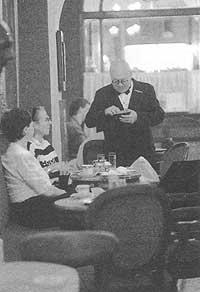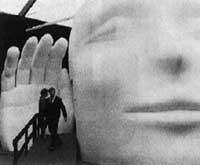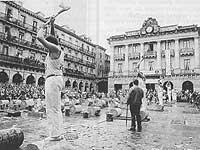Keep the fine ability standing!
1991/05/01 Bardino von, K. Iturria: Elhuyar aldizkaria
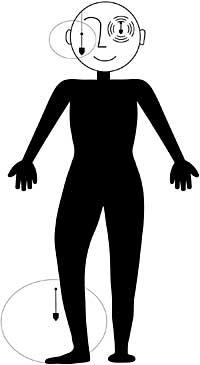
Waiting for the arrival of the bus or the payment in the supermarket; at the arrival of the race; to enjoy with tranquility a good work in the museum. Standing, of course. It does not seem complicated. However, not all of us do it well. Some, when standing, keep one shoulder above the other. Others have their backs bent forward. But it is true that in these things of maintaining the position well placed there are authentic artists. There are the mimes that, without moving, know to pretend they are of stone or the famous garrison of the Buckingham Palace. Clumsy or artist, we all have to use a lot of information and more of a feeling to keep us standing without falling.
How we stand up
If we put the articulated puppet standing and release it, it will come from top to bottom immediately. Having joints, the pieces move and fall by weight.
We will take the rigid doll for the next essay. If while standing we blow at the height of the feet, it will be unbalanced, the balance will begin and fall.
How do we get us to stand up? Because we are endowed with a complex system capable of overcoming these barriers, which tends to stabilize our balance constantly.
First we need a support. This is provided by the bone set and are bones joined by joints that allow us freedom of movement. And then the movement. This is due to contractions of the muscles associated with these bones.
When we stand there is a force that affects us from the outside: our own weight. Because of this strength, the heads and bodies tend to fall forward, the skirts flex over the legs and the legs slide over the feet. To be still, that force must be actuated on the other hand. That is the role of the muscles: we contract them and thus avoid those movements that would happen themselves. This is called muscle tone. When this tension relaxes, we fall without remedy.
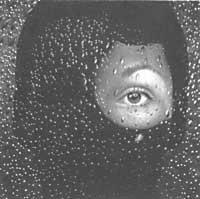
But that is an explanation that only takes into account the mechanical aspect. How do we manage to maintain balance in a position? How do we get that when the wind sounds, standing or bent, but keeping the stance? For this to happen, it is clear that we have a way to know the inclination of the body and to know the adjustments and corrections that we must make on the vertical.
A really complex system
We process three types of information that we obtain through the senses to balance the posture: those obtained with inner ear, vision and sensations that we receive from the feet.
The ear informs nerve centers about the orientation and acceleration of the head. This information comes to us through the sensory cells we have in the semicircular channels and in the otolithic system, since at every moment they communicate the position to the nervous system. If we give you very continuous agitations to the head, these cells have too much information in a short time. They are uncontrolled and, as a result, the fall to the ground is not difficult either.
The second source of external information is the feet. We need two information: contact with the floor and position with the leg of the foot.
The third and last source of information is the eye. Vision has great importance in the ability to maintain posture. And if not, try: try to keep the balance on a leg. With open eyes you can check that it gets much easier than with closure.
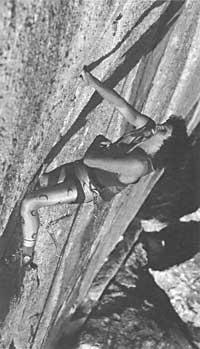
The halls, feet, and eyes of the inner ear are not enough. In addition to all the information we receive from the outside, we need other interior oriented elements. The first is the movement of the eyes. This gives a position regarding the lobby of the eye. The second is the information that is obtained from the cluster muscles. These muscles are located on both sides of the column and communicate the position with the head of the lower limbs.
Knowing all the information so obtained, we can know our position in space at every moment. All this information goes to the nerve centers, from which automatically arrive the necessary orders for balance by controlling the muscle tone. This automatism is called postural system.
Posturology at work
Posturology, which seeks its place in the field of medicine, aims to analyze the postural system and develop appropriate diagnostic and healing techniques in postural problems.
We have seen that it is possible to manipulate the information inputs of the postural system. For example, we can ask a person who has eyes closed or open and thus force his postural system to act differently. The realization of this type of tests has allowed to know that the postural system is up to 250 times more accurate when access to vision is available.
As mentioned above, the information we receive from different sources is not used in any way, but in contact. Consequently, in cases where there is a failure in the movement of the eyes or in the functioning of the lobby, the information obtained through the view does not have great value. In these cases it is impossible to decode this visual information. We will say that whoever has this error is postural blind.
For about ten years we know that when the child of a year begins to take his first steps, if he is blocked to see that he cannot stand. More recent studies have explained that not even ten year old children have fully integrated sight into the postural system. The concept of postural blindness should be applied, therefore, only to the adult who stands better than with closed eyes.
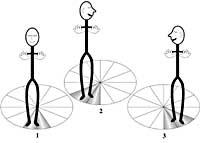
The postural reaffirmation techniques of the indications are not very complex: the key is in the visual functioning of the postural system. For this purpose the patient sits in a chair that rotates to cut the information of the lobby and climbs to an unstable platform to also cancel the information of the feet. As you only have the information you receive through the view, you must take advantage of it to keep it standing. After three months of exercise, the patient has usually recovered his postural system.
Another type of problems that studies posturology is the so-called post-cultural reflex. To analyze what these reflections are, we will see what the test invented by the Japanese doctor Fukuda consists of. If a person gently hits the heel with closed eyes and arms stretched forward, raising little feet, he will see that he will turn to one side and another on his axis. The fuero test measures the size of this deviation. Normally this deviation is less than 30.
The same test, but with the head turned to the right, the body rotates quickly to the left. And on the other hand, with the head turned to the left and in the heel, the body moves to the right. This test launches the so-called nut reflex. This reflex is due to the muscles of the neck. If a person does not respond correctly to the test is because their neck muscles do not act symmetrically.
Other similar tests allow to know the tone of the different muscles and thus correct postural problems.
As we have seen, our way of directing the stance is to influence the inputs or inputs of the postural system. The vision allows to reconstruct the symmetry of muscle tone and fix postural balance.
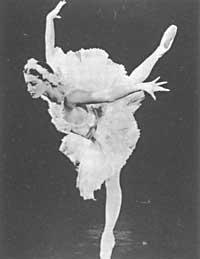
Let's see another example. Children with strabismus bend their feet inward when they walk and have torticollis is not rare. Their postural system is lost because they make an erroneous interpretation of the visual information of space.
The use of prisms for these cases has been proposed. The objective of these prisms is to move the image to compensate for the proper error of the eyes. With these prisms, therefore, the view would be corrected and thus avoid the harmful effects that visual failure can cause in the posture.
As we have seen, standing up requires a fine ability. Science has to analyze the mechanisms of this ability and posturology is on that path.

Gai honi buruzko eduki gehiago
Elhuyarrek garatutako teknologia



